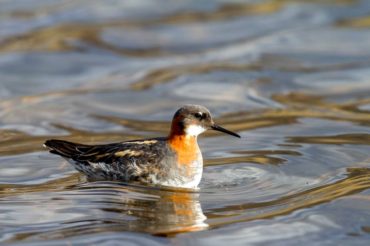
A ferry ride is an inexpensive way to do some birdwatching on the water. You don’t pay for an expensive guided tour. You don’t need to own or care for your own boat.
Birding surprises often occur on many of the available ferry crossings throughout Western Washington’s “Inland Sea.” All ferry runs can produce good birding but some are better than others.
The Kingston-Edmonds route is a favorite because it is easy to reach. Parking is available close to the dock and marina. It also fronts on Admiralty Inlet’s open water that marine birds favor.
Not only is the birdwatching on the water good, but birding around the terminal also produces interesting birds. From midsummer through fall, this region is excellent for seeing Heermann’s gulls, parasitic jaegers, and common and Arctic terns.
From the ferry between Kingston and Edmonds, a seasonal birding highlight is the red-necked phalaropes. This bird that nests in the far north migrates through these waters by the thousands.
It is possible to see large numbers of them on this ferry run. Sometimes it may only be a small flock. The birds and their actions make them easy to identify. They have a unique way of feeding.
Phalaropes look like small sandpipers floating on the waves. They spin round and round on the water. At the same time, they dip their bills into it. The spinning motion stirs up small marine life found in the waves and the dipping takes place as the busy bird picks up these creatures.
Parasitic jaegers also nest in Arctic regions and migrate southward each fall. Their name describes the actions they are best known for. Jaegers can often be seen chasing and harassing gulls with food in their mouths. They will chase the gulls until they disgorge the food and the jaeger gets it without doing any of the hunting.
The ferry run between Bainbridge Island and Seattle also attracts some distinctive marine birds. Double-crested cormorants perch on the ferry dolphins both in Winslow and the Seattle terminal. They also roost in Bainbridge’s Eagle Harbor near the ferry operations. The route between Bremerton and Seattle may encounter pelagic cormorants and harlequin ducks.
Ferry crossings on the Olympic Peninsula reach Whidbey Island and British Columbia. The seabird population in the Strait of Juan de Fuca and Admiralty Inlet is some of the most varied throughout Western Washington.
Birds can be seen both on the crossings and in the waters around the terminals. As more and more migrants and the young birds raised this summer leave their nesting areas, the bird population will swell to its largest numbers of the year.
This is the best time to enjoy the Inland Sea waters and ferryboat birding is accessible from much of the West Sound region. All that is needed is a ticket, field guide and binoculars. The weather can be perfect at this time of the year and your birding often begins before the boat leaves the dock.
























